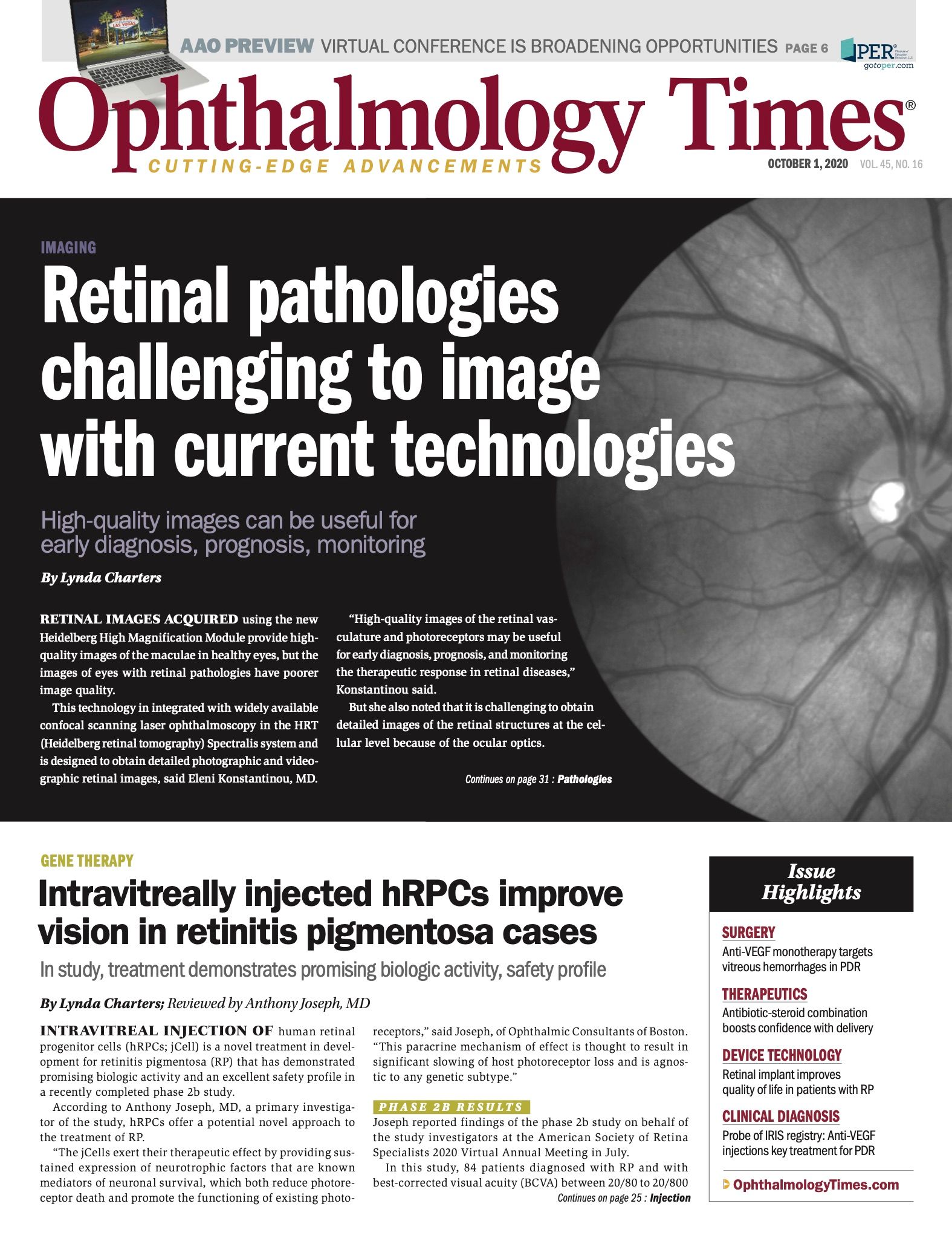Publication
Article
Digital Edition
Small-aperture single-piece IOL could fill unmet need in patients
Author(s):
Optics block out-of-focus and stray light, allow continuum of vision.


Special to Ophthalmology Times®
Aproved for use in Europe, the small-aperture IOL IC-8 (AcuFocus) is proving to be a very useful implant, particularly for patients who are not good candidates for current multifocal (MF), accommodating or extended depth-of-focus technology.
The small aperture lens approach to vision correction is based on pinhole optics – a novel property not found in other available lenses.
The pinhole optic blocks out-of-focus, stray light, thereby creating a depth of focus with the small aperture of 1.36 mm allowing for a continuum of vision.
Related: Aspheric, aberration-free IOL leverages technology for performance
The lens is forgiving, with a broad landing zone that makes it virtually immune to up to 1.50 D of astigmatism, while at the same time offering high-quality, sharp vision and less concern with photic phenomena.
The IC-8 is a single-piece, hydrophobic acrylic IOL embedded with an opaque mini-ring. Besides Europe, it is also approved for use in Asia and is currently being investigated in clinical trials in the United States.
A retrospective comparative review of studies assessed the range and quality of vision with small-aperture, accommodating or MF IOLs.1
The IC-8 IOL was found to enhance vision at all distances, with improved visual acuities and a broad range of continuous functional vision.
Likewise, the patients receiving this implant experienced excellent intermediate vision and binocular mesopic contrast sensitivity, which is comparable to the other lenses.
Related: Getting it right: There is no magic bullet for IOL calculations
Review of the evidence
The small-aperture IOL was paired with an aspheric monofocal IOL and compared with bilateral implantation of the MF lens Acrysof ReSTOR +3.00 D (Alcon) and MF IOL Tecnis +4.00 D (Johnson & Johnson Vision), and with the accommodative Crystalens AO (Bausch + Lomb).
The IC-8 cohort comprised 105 patients, with the Restor, Tecnis and Crystalens platforms implanted into 25, 22 and 26 study subjects, respectively.
Investigators examined 6-month postoperative monocular uncorrected and distance-corrected vision at distance (4 m for IC-8, 6 m for others), intermediate (67 cm for IC-8, 80 cm for others) and near visual acuities (all 40 cm).
They looked at defocus curves (binocular for IC-8, monocular for others) and compared binocular mesopic contrast sensitivity with and without glare.
Related: ASCRS 2020: Assessing aberration of monofocal toric IOL with enhanced optic recovery, alignment
Defocus curve
The defocus curves revealed that the small-aperture lens had a 4.50 D continuous expanse of vision compared with 4.50 D for Restor, 4.00 D for Tecnis and 2.50 D for Crystalens – but the two light-splitting lenses were not continuous.
Rather, they showed a dip in the middle range for intermediate vision of patients.
All four IOL groups had a similar mean uncorrected distance visual acuity (0.02–0.11). The small-aperture lens and Crystalens had a mean uncorrected intermediate visual acuity of 0.08 and 0.07. This was almost a 2-line improvement over Restor and Tecnis (0.24, P<0.0001).
Related: Pinhole camera effect in small-aperture implant corrects presbyopia in patients
Symptomology
Unwanted visual effects such as blurring, fluctuating vision and ghosting were of low severity in all the lenses studied, with a very low ghosting score for the IC-8 lens.
Along with the Crystalens, the small-aperture IOL elicited very few reports of halos when both were compared with the two MF lenses, which received higher scores for halo and glare.
With regards to the contrast sensitivity that patients experienced, the lenses were binocularly comparable.
The small-aperture lens group was worse than Crystalens at 6 cycles per degree (cpd), but better than Tecnis at 3 cpd, and with no glare (P<0.05 ).
Related: Trifocal IOL a key for premium cataract surgery practice
Summary findings
When compared with accommodating or MF IOLs, the IC-8 IOL enhanced vision at all distances and provided both improved visual acuities and a broad range of continuous functional vision.
Likewise, the patients receiving this lens experienced excellent intermediate vision and binocular mesopic contrast sensitivity comparable to the other lenses.
The IOL has minimal impact on the ability to visualise the retina with optical coherence tomography or on visual fields. One study recently showed that even with bilateral implantation, patients experience a minimal change in contrast.1
Related: Changing focus of accommodating IOLs now reaching a new level
Moreover, the expanded depth of focus with the small-aperture lens allows refractive surgeons to target roughly -0.75 D without really losing much distance.
The IC-8 lens proved tolerant of up to 1.00 D deviation from the refractive target and it corrects up to 1.50 D of corneal astigmatism free from the concerns that accompany toric technology. One should remember that every degree of rotation is about a 3.3% reduction in the offset of the astigmatism.2
In addition, toric lenses do not come in every power. Even just 0.75 D of residual astigmatism has a significant impact on MF lens performance at all distances.
Conclusion
The IC-8 IOL should prove particularly useful for patients with previous refractive surgery or highly aberrated corneas, extending to those with irregular astigmatism from trauma, a small iris defect or in patients with a pupil that is not completely round.
Also, in eyes with a high angle kappa, the central ray can traverse the central ring and adversely affect the performance of multifocal IOLs, whereas the implant will not be impacted and should be a ‘shoo-in’.
Related: Finding an option with presbyopia-correcting IOLs
For those patients who are not good candidates for other premium technology, the IC-8 lens gives surgeons something unique to offer.
This IOL is forgiving in terms of hitting both targets, sphere and cylinder with a broad landing zone; has a very low dysphotopsia rate; and results in high patient satisfaction.
In fact, 95% of small-aperture patients reported that they would undergo the procedure again.
About the author
Jay Pepose, MD, PhD
e:jpepose@peposevision.com
Pepose is a professor of clinical ophthalmology at Washington University’s School of Medicine, United States, and director of the Pepose Vision Institute in St. Louis, Missouri. Dr Pepose is an investigator for the IC-8 IOL clinical study.
---
References
1. Ang RE. Visual performance of a small-aperture intraocular lens: first comparison of results after contralateral and bilateral implantation. J Refract Surg. 2020;36:12-19.
2. Novis C. Astigmatism and toric intraocular lenses. Curr Opin Ophthalmol. 2000;11:47–50

Newsletter
Don’t miss out—get Ophthalmology Times updates on the latest clinical advancements and expert interviews, straight to your inbox.




